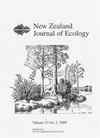奥克兰岛本地消灭野猪方法的初步研究
IF 1.4
3区 环境科学与生态学
Q3 ECOLOGY
引用次数: 6
摘要
自1807年被解放以来,野猪(Sus scrofa)对新西兰奥克兰亚南极岛的生态系统健康和过程产生了负面影响。根除外来入侵物种往往是恢复方案和防止物种灭绝的关键。采用多种技术的根除计划已使大型岛屿上的野猪得以根除。由于生物、后勤、社会和资金支持等因素,长期的根除规划可能有更高的失败风险。在奥克兰岛一个951公顷的植被密集的围栏半岛上,成功地实施了一项临时的本地猪根除试点研究,模仿了圣克鲁斯岛(美国加利福尼亚州)根除过程中制定的原则。我们采用了多种技术,每种技术在适当的猪群密度和有限的时间内交付,以减少根除失败的固有风险。在一个小组使用经过特殊训练的狗进行系统的地面狩猎之前,使用空中狩猎来减少猪的数量,以清除幸存者并验证根除成功。在这个试点研究中,以一种特殊的方式部署了一个高规格的热红外或前视红外(FLIR)摄像机,大大提高了空中搜索的效率。使用被动诱捕、犹大猪和将岛屿划分为较小的围栏单元是奥克兰岛根除的补充方法,以提高根除效率,因为这里实施的方法正在扩大规模。本文章由计算机程序翻译,如有差异,请以英文原文为准。
A local eradication pilot study of methods for feral pig eradication on Auckland Island
: Since their liberation in 1807, feral pigs ( Sus scrofa ) have negatively impacted ecosystem health and processes on subantarctic Auckland Island, New Zealand. Eradication of invasive alien species is often critical to restoration programmes and preventing species extinctions. Eradication programmes utilising multiple techniques have allowed feral pig eradications on large islands. Protracted eradication programmes can have a higher risk of failure due to factors such as biological, logistical, social, and funding support. A temporary local pig eradication pilot study was successfully implemented on a densely vegetated fenced 951 ha peninsula on Auckland Island, emulating the principles set out during the Santa Cruz Island (California, USA) eradication. We applied multiple techniques, each delivered at the appropriate pig population density and within a finite period, to reduce the inherent risk of eradication failure. Aerial hunting was used to reduce the pig population before systematic ground hunting by a team using specially trained dogs removed survivors and validated eradication success. The deployment of a high specification thermal or forward-looking infrared (FLIR) camera in a particular manner greatly improved the efficiency of aerial hunting during this pilot study. The use of passive trapping, Judas pigs and division of the island into smaller fenced units are supplementary methods proposed for the Auckland Island eradication to enhance eradication efficiency as the methods implemented here are scaled up.
求助全文
通过发布文献求助,成功后即可免费获取论文全文。
去求助
来源期刊

New Zealand Journal of Ecology
环境科学-生态学
CiteScore
3.00
自引率
12.50%
发文量
35
审稿时长
>36 weeks
期刊介绍:
The New Zealand Journal of Ecology is a biannual peer-reviewed journal publishing ecological research relevant to New Zealand/Aotearoa and the South Pacific. It has been published since 1952 (as a 1952 issue of New Zealand Science Review and as the Proceedings of the New Zealand Ecological Society until 1977). The Journal is published by the New Zealand Ecological Society (Inc.), and is covered by Current Contents/Agriculture, Biology and Environmental Science, GEOBASE, and Geo Abstracts.
 求助内容:
求助内容: 应助结果提醒方式:
应助结果提醒方式:


